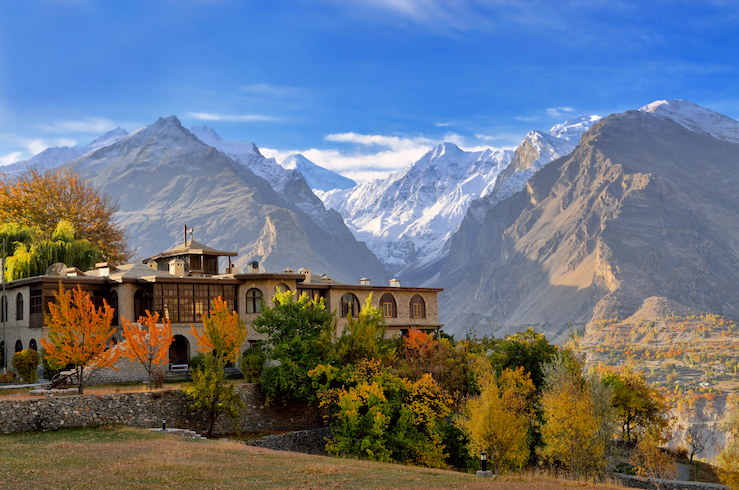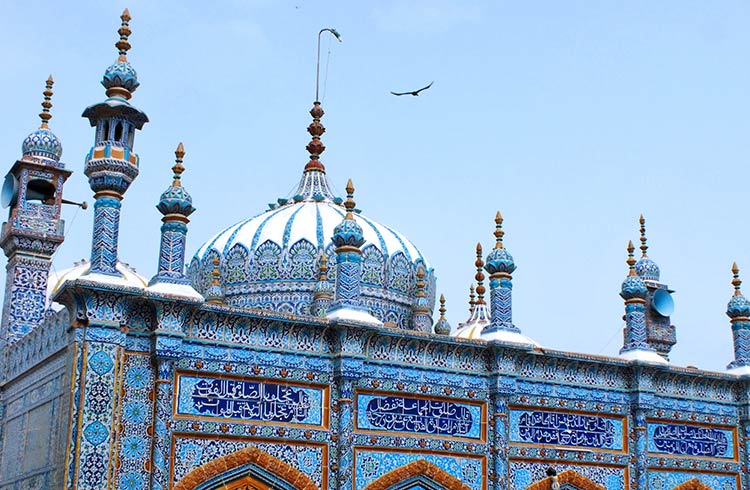Is Pakistan Safe? Essential Travel Tips for Visitors
The terrorism threat in Pakistan has been greatly reduced in recent years – most regions are now safe to visit, but a few are still best avoided. Nomad Will explains the current security situation in one of his favorite countries.
 Photo © Getty Images/Shehzaad Maroof
Photo © Getty Images/Shehzaad Maroof
Pakistan has had a tumultuous past. Taliban activity peaked between the late 2000s to early 2010s and for many years, the country as a whole was seriously unsafe to visit. But thanks to the hard work and vigilance of the country’s intelligence agency and military, Pakistan has largely turned its situation around and most areas are now safe for travelers to visit.
This is a country with so much to offer: welcoming people, fascinating culture, ancient history, and some of the most stunning and unspoiled mountains in the world, Pakistan is one of the last true adventure travel frontiers and every year more foreigners go backpacking here. While most Western nations still advise against travel to all or parts of the country, Pakistan’s tourism industry is growing steadily as it rebuilds its once-thriving adventure travel scene. Always check with your government's travel advisory body to stay up to date with changes that could affect your travel insurance cover.
- The current terrorism situation in Pakistan
- Places in Pakistan travelers should avoid
- Types of events to avoid in Pakistan
- Public transport in Pakistan
- Safety concerns for women
The current terrorism situation in Pakistan
After years of instability and occasional acts of sectarian violence, Pakistan’s security is now solid, and the majority of the country has been safe for visitors for several years. Aside from a few areas, listed below, traveling in Pakistan is no more dangerous than traveling in neighboring India, and for women, Pakistan is actually safer than India.
What’s more, the parts of the country that attract the most travelers – such as Lahore, Islamabad, Karachi, Gilgit-Baltistan, Swat Valley, and Kalash – are all now very peaceful places to visit.
But even though the majority of the country is safe, there are still some events and locations that are best avoided. It’s pretty easy to avoid these places, though, as they are difficult or impossible for foreigners to reach without an NOC (Non-Objection Certificate), a permission form which is more often than not challenging to obtain from the police.
Adding to the safety situation is this: any time the government feels even slightly uneasy about a foreigner being in a specific location, they’ll assign a police escort. Not exactly ideal for adventurous independent backpackers, but certainly another layer of protection, nonetheless.
Places in Pakistan travelers should avoid
Former FATA Region of Khyber Pakhtunkhwa province (KPK)
Prior to 2018, an area existed in Pakistan known as the Federally Administered Tribal Areas (FATA) that included several tribal agencies and six frontier regions.
Out of these, North and South Waziristan have been and still are particularly prone to terrorist activities and attacks due to their proximity to and relationship with Afghanistan.
All of the former FATA region is now officially a part of the Khyber Pakhtunkhwa province, yet tourists would never accidentally end up there due to numerous police checkpoints on the way in.
Torkham Border
Pakistan and Afghanistan share a border at Torkham, and it is officially open for immigration.
Numerous travelers with valid Afghan visas have crossed over from Pakistan in recent years without incident, but the Afghanistan side of the border is highly unstable and sees frequent bombings and other attacks.
If traveling to Afghanistan from Pakistan, I highly advise you travel by air, as Torkham is not a casual border crossing like Wagah over in Punjab.
Kohistan
Kohistan is a district of KPK that runs roughly from Dasu to Chilas along the famous (and rightly so) Karakoram Highway. At present, the region is relatively safe, but this is a very conservative part of Pakistan and in the recent past there have been terrorist attacks and extremist sectarian violence.
Like most other “unsafe” places in Pakistan, you will not be allowed to spend any time freely traveling here as a tourist. It is, however, highly likely you will pass through this part of Pakistan on your way up to Gilgit Baltistan. There are many police checkpoints where passport copies are taken, and in the unlikely event you find yourself stuck there overnight, security will be provided free of cost.
Azad Kashmir LOC
India and Pakistan have a difficult relationship, and nowhere is it more evident than Azad Kashmir. While the province itself is generally safe from terrorism and foreign tourists can now visit the cities of Muzaffarabad and Mirpur, towns and villages near the LOC (line of control) see occasional crossfire, attacks, and killings.
There’s really no need to worry about this, though – various checkpoints ensure that travelers don’t get anywhere near this turbulent border.
Balochistan
Pakistan’s largest and least-visited province is virtually off-limits for foreigners, due to various threats from Balochi separatist groups and the fact that the Pakistani government is not keen for foreigners to witness the questionable tactics involved with squashing these groups.
Public buses, luxury hotels such as the Serena, and local bazaars have all been the target of recent attacks in Balochistan. The city of Quetta, in particular, is quite unstable, and you will not be able to spend any time here alone. If you are crossing into Pakistan via the Taftan Border with Iran, you will have a full security team with you 24/7 all the way until Karachi.
The regions of Balochistan along the Makran Coastal Highway, including Pakistan’s magnificent Hingol National Park, are relatively safe to visit and are becoming more and more popular with domestic travelers. But as a foreigner, it’s unlikely you’ll be able to make it here without local connections and/or a NOC. This is, however, likely to change in the next couple of years.
Places in KPK that are safe for travelers
Western governments often specifically mention KPK in their travel advisories, declaring the entire province to be seriously dangerous. But the reality is, the few places that travelers can and do visit are now safe from terrorism.
Peshawar, Mingora, Swat Valley (yes, Swat Valley was very dangerous 12 years ago, but today it’s at total peace) Chitral, the Kalash Valleys and Upper Chitral are all stable and often included in foreign visitors’ itineraries. As of 2019, foreigners have also been able to move about these specific locales without escorts.
Types of events to avoid in Pakistan
As with any country, it’s best to avoid political rallies or protests. Political violence does happen occasionally, but this is absolutely not targeted at tourists/foreigners.
Madrassas (Islamic schools) have also been the target of terrorist attacks. It’s very unlikely that you’d be visiting one, so they’re easy to avoid.
Minority religious events like Sufi festivals and Shia processions have also been the target of terrorist attacks in years past, such as the bombing of Lal Shahbaz Qalandar Shrine in Sindh Province in 2017.
If you do plan to attend a gathering like this, it’s best to go along with a local friend. Even so, tourists have visited such places (including Lal Shahbaz Qalandar) without issue in recent years.
Public transport in Pakistan
Public transport is the best way to travel in Pakistan if you don’t fancy learning how to ride a motorbike, and it’s safe for travelers these days.
Public transport often comes in the form of shared local jeeps or cars, which actually tend to be the most low-profile modes of travel. Additionally, NATCO is a government-run bus/van service that operates in and to Gilgit-Baltistan.
Pakistan also has two “expensive” private bus options for longer routes: Daewoo and Faisal Movers. Both are professionally operated, have reclining seats, and often have a security guard on board.
Hitchhiking is another common way of getting around in Pakistan, and if you have experience doing it, go ahead. General safety isn’t as guaranteed as the bus/jeep/car options, but from a terrorism perspective, there is very little risk.
Safety concerns for women
There are no specific safety concerns women should have about terrorism in Pakistan. Nevertheless, if you plan to venture off the beaten track areas or manage to obtain a NOC to a restricted area, wearing local dress and covering your hair is always a smart move.
Women should also refrain from giving their phone number out to men they do not know, as harassment via text is a significantly more legitimate concern than terrorist violence. Do your research before you come to Pakistan and read this guide on what you need to know as a female traveler in Pakistan.
Related articles
Simple and flexible travel insurance
You can buy at home or while traveling, and claim online from anywhere in the world. With 150+ adventure activities covered and 24/7 emergency assistance.
Get a quoteComments have been disabled for this content.


3 Comments
Allahhamdulleh pakistan a safe country love u all
Pakistan is best place for tourism especially punjab, kpk, Gilgit Baltistan have many places to enjoy your journey....
PAKISTAN IS a SAFE country, I have travelled there twice with such hospitailty that is unbelivable